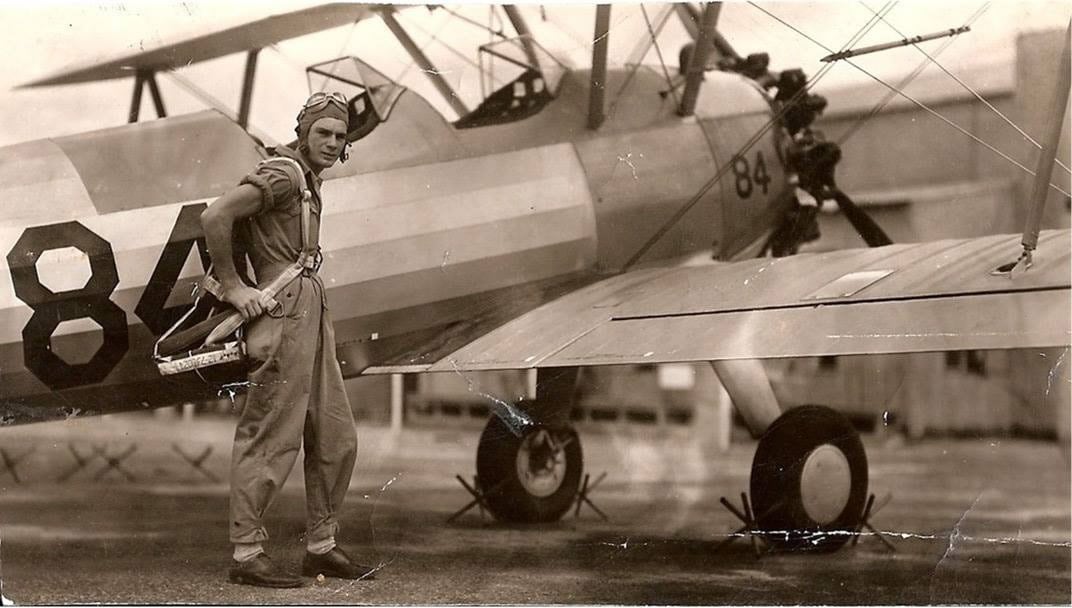
As a World War II fighter pilot, Joe Peterburs remembers flying with a wingman who always “had his six.” It was a little different this past weekend when the 100-year-old veteran soared into the skies in a vintage North American P-51H Mustang from California Redwood Coast-Humboldt County Airport.
This time, his wingman was his granddaughter, Sabrina, who was buckled into a P-51D Mustang alongside his plane as they flew along the Pacific Coast.
“Her wingtip was about two feet away from mine,” he recalled in a Zoom interview. “We were flying in close formation and we were waving to each other. She was smiling and was really happy. She almost filled that rear cockpit up with tears, she was so emotional.”
It was also quite a moment for Peterbus, who also flew in the P-51D the day before at the Rumble Over the Redwoods Air Show. He was reuniting with two of the aircraft he piloted over Germany in World War II and in close air support for ground troops during Korea.
“In World War II, the P-51 was the only plane I wanted,” he said. “It was like putting on a suit of armor. It was such a comfortable aircraft to fly.”
However, that perception changed by time the jet war stared in Korea. “There, the P-51 was the worst aircraft you could have. It was very vulnerable to ground fire. The engine was liquid cooled. If you got a bullet through the wrong tube, you were gone.”

Lt. Joseph Peterburs of the U.S. Army Air Corps was barely 20 when he flew “Josephine” — named for his girlfriend and later wife — on his first combat mission on Dec. 2, 1944. He and other flyers in the 55th Fighter Squadron of the 20th Fighter Group escorted a large group of Boeing B-17 bombers to and from targets in Merseburg, Germany. He had a deep admiration for the men who flew the lumbering Flying Fortresses, which were easy targets for enemy fighters and antiaircraft fire.
“In my 49 missions, I never saw a bomber waiver or be deterred from his mission,” he recalled. “These men were and are the bravest of the brave and I only hoped that I could have come close to such courage.”
The young fighter pilot flew his final combat mission on April 10, 1945 — less than a month before the end of combat in Europe. After escorting bombers, his squadron searched for targets of opportunity and began strafing a German airfield. That’s when he felt two thumps and realized his P-51 had been hit antiaircraft blasts.
Peterburs bailed out of his damaged plane and was captured by the Germans. He was sent to a POW camp, which he escaped from and then met up with advancing Soviet troops. His Russian hosts treated him and other escaped airmen to dinner with continuous toasts of wine and vodka.
“I had never consumed that much alcohol in my life, nor have I since,” he said.
That last mission turned out to be noteworthy for another reason. Peterburs spotted a Messerschmitt Me 262 that had just shot down two B-17 bombers. He zoomed in on the German jet and opened fire with his six 50-caliber machine guns. The American noticed smoke coming from one of the engines of the enemy fighter, which then ducked into a cloud bank.
Peterburs never gave much thought to what happened to the Me 262 — until 60 years later, when a historian identified him as the pilot who shot down Walter Schuck, one of Germany’s top aces with 206 confirmed kills. After entering the cloud, Schuck’s jet fighter disintegrated, forcing him to bail out. The two men met face to face in 2005 and became fast friends.
“He was a real gentleman,” Peterburs recalled. “When we did air shows together, he introduced me as ‘the man who saved his life’ because he never flew combat again after I shot him down.”
As a result, Peterburs became one of the few American pilots to down an Me 262 in air-to-air combat, earning him his only kill for the war. He also has credit for destroying five aircraft on the ground.

After World War II, Peterburs remained in the military, joining the U.S. Air Force when it was established in 1947. He flew 76 combat missions with the Mustang in Korea, then switched to jets with the Lockheed P-80 Shooting Star in 1954. In Vietnam, he served as a staff operations officer responsible for command and control in the war zone. Later, he was commander of the 600th and 601st tactical air control units and then deputy commander of the 601st Tactical Control Wing in Europe.
In 1979, Peterburs retired as a full-bird colonel. His awards include the Legion of Merit, Distinguished Flying Cross, Bronze Star, Purple Heart, Air Medal and POW Medal.
At 100 years old, Peterburs did not expect to be flying at Rumble Over the Redwoods on Aug. 9 and 10. But there he was at the controls of the two-seat P-51s, pulling 4Gs in loops and other aerobatic maneuvers.
“I also did a victory roll,” he said with a big smile.
Of course, Peterburs never dreamed he would ever be flying with his granddaughter as wingman. That experience is one he will never forget.
“It was so heartwarming to look over and see her there,” he said.
It was also a memorable moment for Sabrina, who had flown with her grandfather before but never in P-51s as a team.
“Nothing could have prepared me for what it felt like to fly side by side with him in Mustangs,” she said. “We flew so close it felt as if our wings could have touched. I looked over and saw him waving, blowing me kisses. My heart melted and tears welled up in my eyes.”
For Peterburs, flying again in a P-51 Mustang brought back a flood of memories, some good and some not so good. He remembered those who didn’t come home, including two of his brothers, who were killed in World War II.
“I like to get the word out to the younger generation about what we went through,” he said. “I hope they understand how many sacrifices young men and women made for their country, so this generation could be free and prosperous and have a decent life.”







-3.png)



